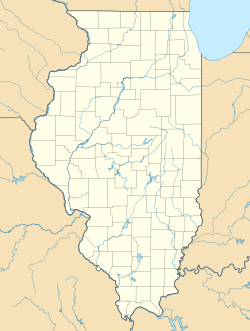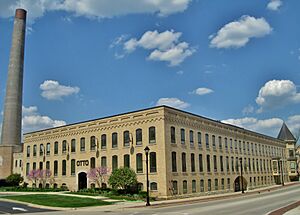Carpentersville, Illinois facts for kids
Quick facts for kids
Carpentersville, Illinois
|
|
|---|---|

Library Hall on Washington Street
|
|
| Motto(s):
"Building a better tomorrow today"
|
|

Location of Carpentersville in Kane County, Illinois.
|
|
| Country | United States |
| State | Illinois |
| County | Kane |
| Area | |
| • Total | 8.08 sq mi (20.93 km2) |
| • Land | 7.87 sq mi (20.39 km2) |
| • Water | 0.21 sq mi (0.54 km2) |
| Elevation | 722 ft (220 m) |
| Population
(2020)
|
|
| • Total | 37,983 |
| • Density | 4,824.46/sq mi (1,862.82/km2) |
| Time zone | UTC−6 (CST) |
| • Summer (DST) | UTC−5 (CDT) |
| ZIP Code(s) |
60110
|
| Area codes | 847 and 224 |
| FIPS code | 17-11358 |
| GNIS feature ID | 2397560 |
Carpentersville is a village located in Kane County, Illinois, United States. In 2020, about 37,983 people lived there. It is part of the larger Chicago metropolitan area.
Contents
- Discovering Carpentersville's Location
- A Look Back at Carpentersville's History
- How Carpentersville is Governed
- Local School Districts
- Carpentersville's Population Changes
- Places to Visit in Carpentersville
- Meadowdale Shopping Center: A Local Landmark
- Transportation in Carpentersville
- Famous People From Carpentersville
- Images for kids
- See also
Discovering Carpentersville's Location
Carpentersville is a village in Illinois. According to the 2010 census, the village covers about 8.1 square miles (21 square kilometers). Most of this area, about 7.9 square miles (20 square kilometers), is land. The rest, about 0.2 square miles (0.5 square kilometers), is water.
A Look Back at Carpentersville's History
Carpentersville was founded by Julius Angelo Carpenter. He was born in 1827 and passed away in 1880. Angelo Carpenter came to the area with his family from Uxbridge, Massachusetts. They settled near the Fox River. Angelo was the first person to build a store, a bridge, and a factory in the settlement. He also served two terms in the Illinois House of Representatives.
In 1837, Julius and his brother were traveling to the Rock River. They stopped along the east bank of the Fox River. They had to wait for spring floods to pass before continuing their journey. They ended up staying in the area. This place was first called Carpenters' Grove.
Transportation and Growth Over Time
For about 100 years, Carpentersville did not grow as fast as other towns along the Fox River. These other towns had better train connections to Chicago. In 1896, an electric train line came to Carpentersville. This line connected the village to Elgin, Illinois. It was very helpful for factory workers traveling between the towns. People also used it to visit Elgin's Trout Park.
However, during the Great Depression in the 1930s, the train line began to struggle. More people started using cars because of new roads like Illinois Route 31. In 1933, a tornado destroyed a bridge over the Fox River. This was the final blow to the train line.
Until the 1950s, Carpentersville was mainly a grid of streets along the Fox River. Main Street was the only bridge across the Fox River for miles. Later, the Meadowdale Shopping Center became a big part of the community. It was so important that it overshadowed the older downtown area. A large part of the shopping center was taken down in the 1990s. A new post office was built there.
Changes in Schools and Recreation
In 1956, Dundee Community High School moved to a new location. This new location is now Carpentersville Middle School. In 1964, a second high school, named for Irving Crown, opened. These two high schools have since joined together.
From 1958 to 1969, Carpentersville was home to the Meadowdale International Raceway. This was a 3.27-mile (5.26 km) long car race track. Today, this site is a Township Park and County Forest Preserve.
In the 1990s and 2000s, Carpentersville started to grow more to the west. Many new neighborhoods and shopping areas were built along Randall Road.
How Carpentersville is Governed
Carpentersville uses a "council-manager" form of government. This means there is an elected Board. The Board includes a President (the main elected leader) and six Trustees. This Board then hires a professional manager. The manager is in charge of the village's daily operations and services. This system combines the leadership of elected officials with the experience of a professional manager.
Local School Districts
Students in Carpentersville attend schools in two main districts:
- Community Unit School District 300 includes Dundee-Crown High School and Carpentersville Middle School.
- Barrington Community Unit School District 220
Carpentersville's Population Changes
| Historical population | |||
|---|---|---|---|
| Census | Pop. | %± | |
| 1880 | 348 | — | |
| 1890 | 754 | 116.7% | |
| 1900 | 1,002 | 32.9% | |
| 1910 | 1,128 | 12.6% | |
| 1920 | 1,036 | −8.2% | |
| 1930 | 1,461 | 41.0% | |
| 1940 | 1,289 | −11.8% | |
| 1950 | 1,523 | 18.2% | |
| 1960 | 17,424 | 1,044.1% | |
| 1970 | 24,059 | 38.1% | |
| 1980 | 23,272 | −3.3% | |
| 1990 | 23,049 | −1.0% | |
| 2000 | 30,586 | 32.7% | |
| 2010 | 37,691 | 23.2% | |
| 2020 | 37,983 | 0.8% | |
| U.S. Decennial Census 2000 2010 2020 |
|||
| Race / Ethnicity (NH = Non-Hispanic) | Pop 2000 | Pop 2010 | Pop 2020 | % 2000 | % 2010 | % 2020 |
|---|---|---|---|---|---|---|
| White alone (NH) | 15,862 | 13,810 | 11,477 | 51.86% | 36.64% | 30.22% |
| Black or African American alone (NH) | 1,234 | 2,399 | 2,152 | 4.03% | 6.36% | 5.67% |
| Native American or Alaska Native alone (NH) | 83 | 42 | 40 | 0.27% | 0.11% | 0.11% |
| Asian alone (NH) | 568 | 2,022 | 1,971 | 1.86% | 5.36% | 5.19% |
| Pacific Islander alone (NH) | 6 | 0 | 3 | 0.02% | 0.00% | 0.01% |
| Other race alone (NH) | 27 | 52 | 126 | 0.09% | 0.14% | 0.33% |
| Mixed race or Multiracial (NH) | 396 | 489 | 843 | 1.29% | 1.30% | 2.22% |
| Hispanic or Latino (any race) | 12,410 | 18,877 | 21,371 | 40.57% | 50.08% | 56.26% |
| Total | 30,586 | 37,691 | 37,983 | 100.00% | 100.00% | 100.00% |
The population of Carpentersville has grown quite a bit over the years. In 2010, there were 37,691 people living in the village. About 11,583 households were counted. The population included people from many different backgrounds. For example, 62.9% were White, 6.8% African American, and 5.5% Asian. About 50.1% of the population identified as Hispanic or Latino.
In 2000, the village had 30,586 people. There were 8,872 households. About 48.6% of these households had children under 18. The average household had 3.45 people. The average family had 3.77 people. The median age in the village was 28 years old. This means half the people were younger than 28 and half were older.
Growth of the Latino Population
Carpentersville has seen a significant increase in its Latino population. In 1990, about 17% of the population was Hispanic. This percentage grew to 40.6% in 2000. By 2010, it was 50.1%, and in 2020, it reached 56.3%.
In 2007, the village of Carpentersville passed a rule. This rule made English the official language for village meetings and notices. This decision was made by village board members.
Places to Visit in Carpentersville
- Carpenter Park
- Carpentersville Dam
- Raceway Woods Forest Preserve
Meadowdale Shopping Center: A Local Landmark
The Meadowdale Shopping Center first opened in 1957. It quickly grew to have as many as 53 stores by 1958. Over time, the number of stores has changed. Today, it includes stores like Walmart and Tractor Supply Company. There is also a large post office.
In 1952, the village of Carpentersville suggested building a shopping center. It would be located within residential areas. Construction planning for the mall began in 1954. It was a huge project for its time. The first 14 stores opened on May 18, 1957. More stores were added later that year.
The Winter Garden Annex and Its History
In 1958, the shopping center opened its Winter Garden Annex. This was an enclosed area with a large ice skating rink. It also had a department store called Block & Kuhl. There were restaurants, a cocktail bar, and other shops. The grand opening included fashion shows on the ice rink and fun activities for kids.
By 1959, a big Wieboldt's department store also opened in the mall. A very important event happened on October 25, 1960. President John F. Kennedy gave a speech there. He talked about his presidential campaign. He spoke about fair education for children and housing.
On November 19, 1963, a fire caused $3,000,000 worth of damage. It destroyed 25 stores and the ice rink in the Wintergarden Arcade. Rebuilding started right away. The mall reopened a year later, on November 5, 1964. However, the ice rink was not rebuilt.
Mall Changes and Modern Day
In the 1980s, the mall started to decline. A new competing mall, Spring Hill Mall, opened nearby in 1980. This new mall had bigger and more popular anchor stores.
In 1989, a large part of the Meadowdale mall was torn down. This was done to make space for new tenants. The Post Office building was made twice as big. By 1990, the mall had fewer stores. Today, it has less than two dozen tenants. These are mainly in the strip mall part of the center. In 2016, a large Walmart store opened at the east end of the mall.
Transportation in Carpentersville
Pace offers bus services in Carpentersville. These buses connect the village to nearby places. You can travel to Crystal Lake, Elgin, and other destinations using these routes.
Famous People From Carpentersville
- Gia Gunn, a drag queen
- Kenneth Hawkinson, president of Kutztown University of Pennsylvania
- Bradie Tennell, a champion figure skater who won the 2015 U.S. Figure Skating Championships and 2018 U.S. Figure Skating Championships ladies competition.
Images for kids
See also
 In Spanish: Carpentersville para niños
In Spanish: Carpentersville para niños










